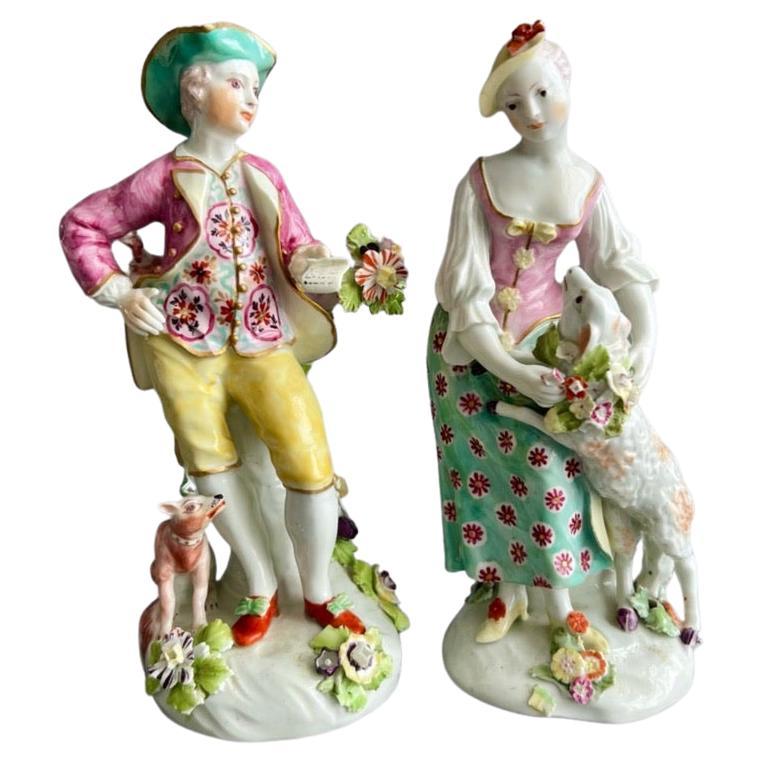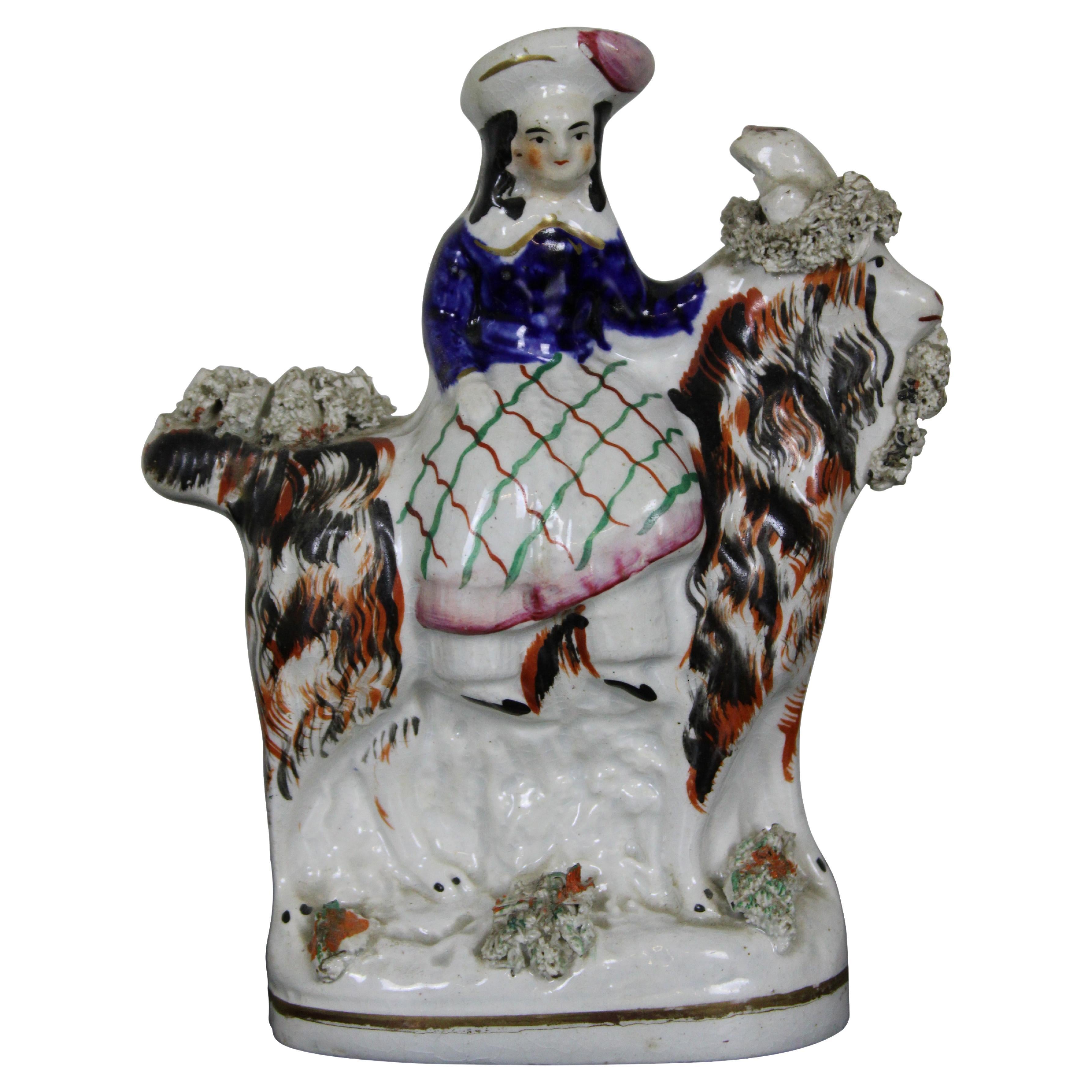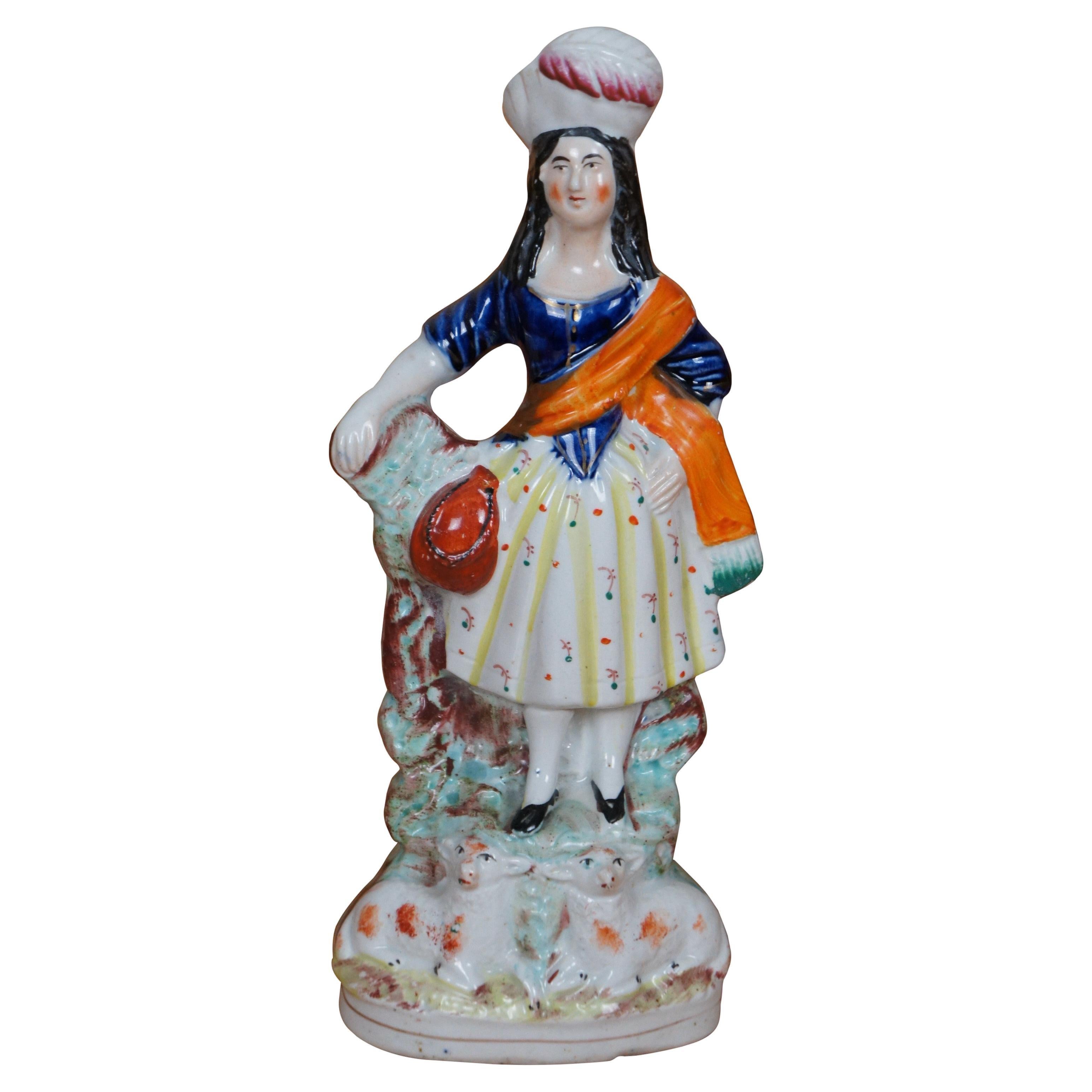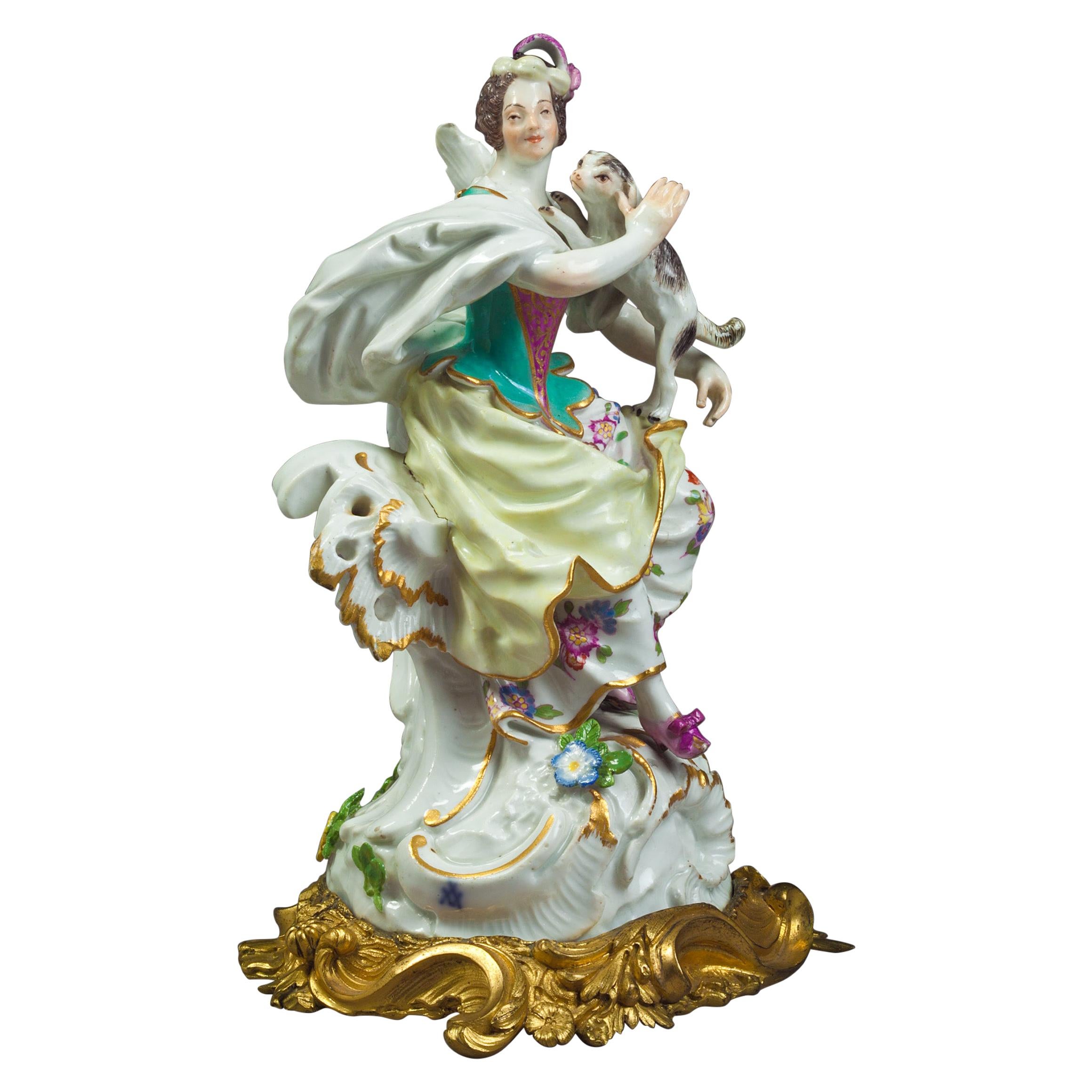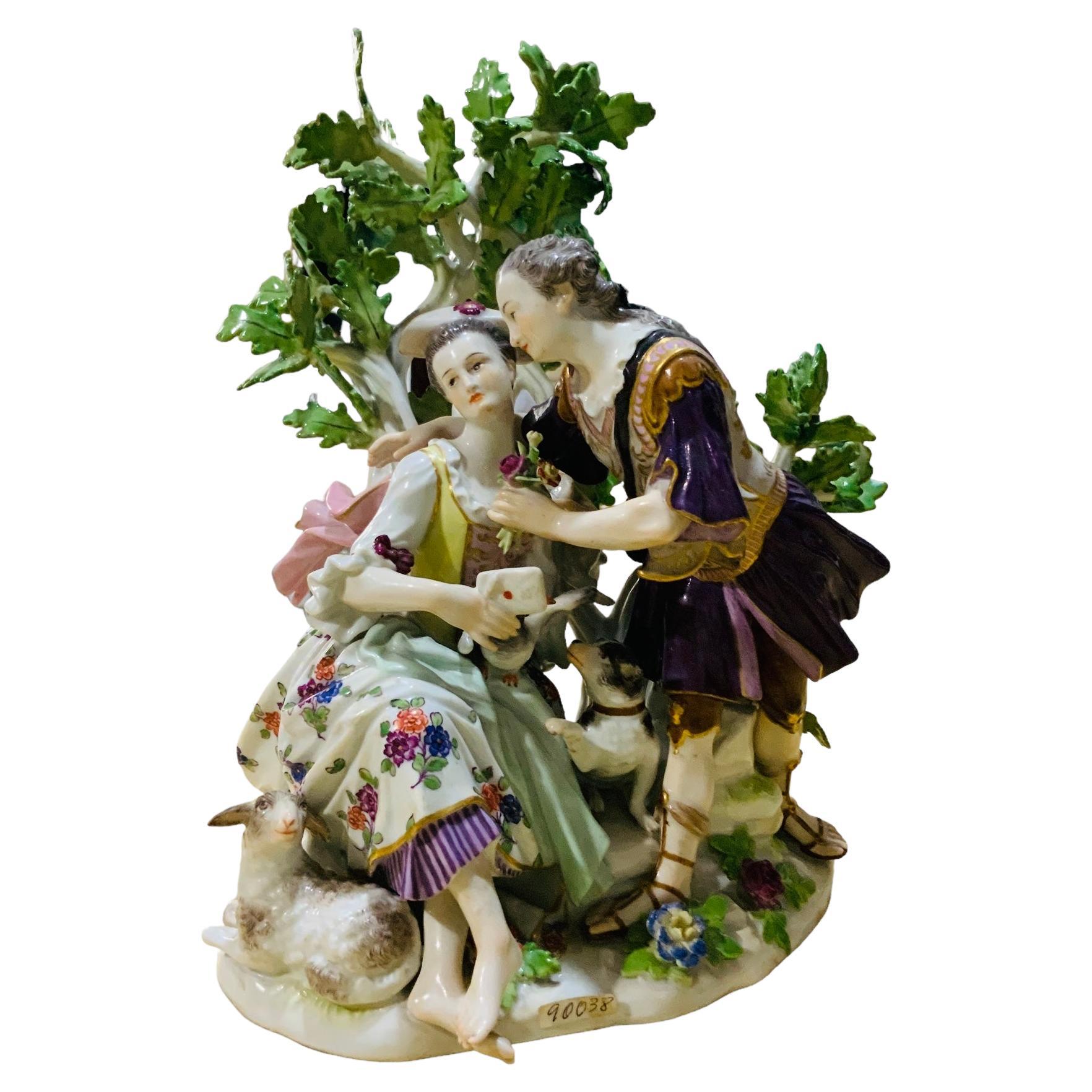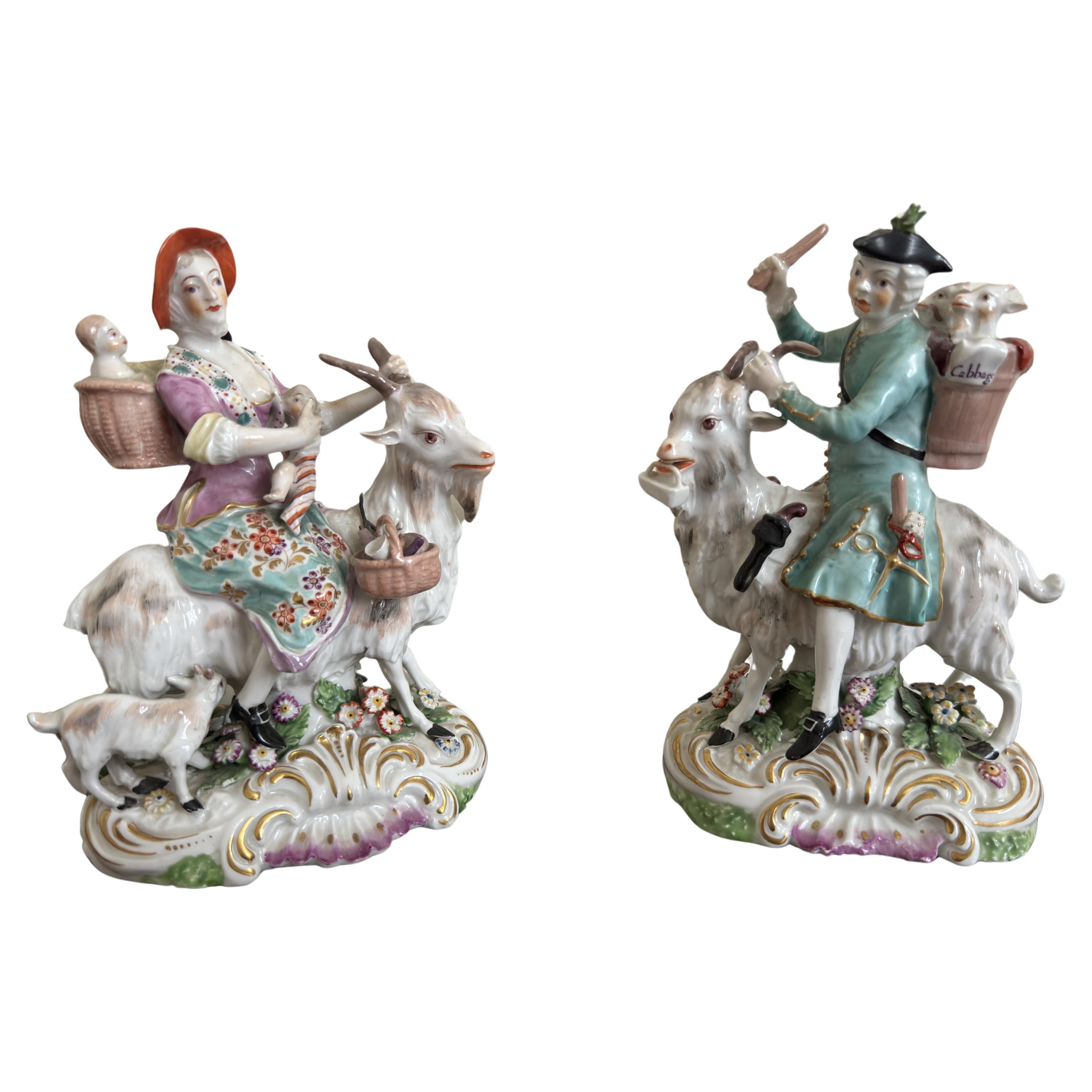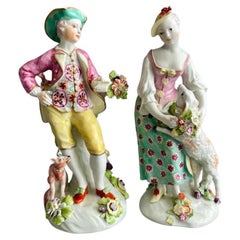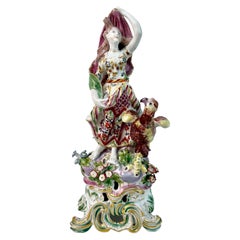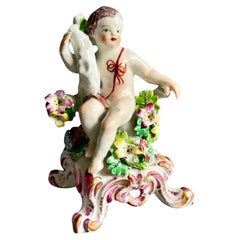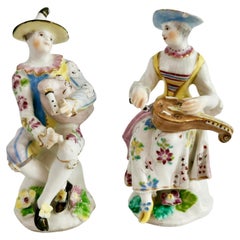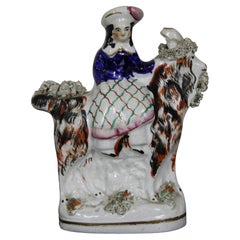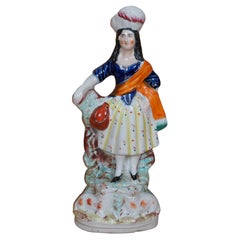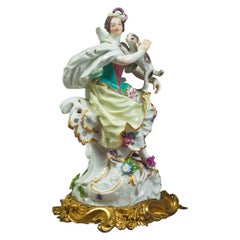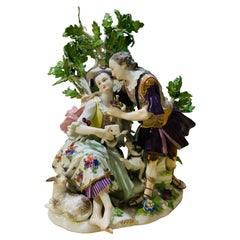Items Similar to Derby Figure of Shepherdess with Garlanded Lamb, ca 1760
Want more images or videos?
Request additional images or videos from the seller
1 of 15
Derby Figure of Shepherdess with Garlanded Lamb, ca 1760
$1,045
£793.76
€914.68
CA$1,471.62
A$1,631.51
CHF 857.42
MX$19,966.97
NOK 10,708.31
SEK 10,050.82
DKK 6,827.55
About the Item
This is a charming Derby figure of a shepherdess with a garlanded lamb, made in or shortly after 1760. The figure is one half of a set called the "Garland Shepherds"; originally she had a male companion shepherd reciting a love letter to her. The item is incised at the bottom with an "N" and has three patch marks. It has beautifully fresh and light paintwork.
The Derby Porcelain factory has its roots in the late 1740s, when Andrew Planché, a Walloon Huguenot refugee, started making simple porcelain toys shaped like animals in his back yard. In 1756 Staffordshire enameller William Duesbury and banker John Heath started a new porcelain factory with Planché and this was to grow out to the largest factory of its time, buying up the bankrupted Chelsea and Bow factories, as well as the stock of several other workshops including that of James Giles. The combination of various traditions, porcelain making skills and sophisticated clients enabled Duesbury to create one of the best porcelain factories of the 18th and 19th Centuries, which after many ups and downs is still operative today.
Derby started making this figure (and her companion) in about 1860. It is not known what the origin is, but it is assumed that it might have been a French engraving after Boucher. This is the first version of several Derby made, with relatively simple clothes painted in very fresh colours, and stood on a lightly Rococo-scrolled ground.
These figures were used to adorn the dinner table when dessert was served; groups of figures served to express something about the host, the guests, or to direct the conversation. One popular topic was an array of romantic rural characters, and this shepherdess is from one such series. A beautiful young shepherdess stands on a Rococo scroll, slightly stooping down to a lamb that is stood up to her in loving embrace, a flower garland around its neck. The figure looks like it previously had a shield of bocage behind its back, but this has either never been attached or it disappeared with the breaking point neatly painted and glazed over.
The figure has an incised "N" at the bottom, as well as three stilt marks from firing. There also is an incised "2", which is probably the number of this figure on a purchase order of many.
CONDITION REPORT: The figure is in beautiful condition with no significant damage, wear or repairs. Presumably, a bocage shield behind the back is broken off, or perhaps it was never added. A few bocage leaves are broken off and the breaking point of the missing bocage was neatly painted and glazed over. There is some kiln dust on the base under the legs of the lamb; this would have happened during the firing process. There are some very light repairs to the arms and hands of the shepherdess. There is a firing crack in the back of the bocage, which is also from production. The colours are very fresh and there is no wear.
Antique British porcelain is never perfect. Kilns were fired on coal in the 1800s, and this meant that china from that period can have some firing specks from flying particles. British makers were also known for their experimentation, and sometimes this resulted in technically imperfect results. Due to the shrinkage in the kiln, items can have small firing lines or develop crazing over time, which should not be seen as damage but as an imperfection of the maker's recipes, probably unknown at the time of making. Items have often been used for many years and can have normal signs of wear, and gilt can have signs of slight disintegration even if never handled. I will reflect any damage, repairs, obvious stress marks, crazing or heavy wear in the item description but some minor scratches, nicks, stains and gilt disintegration can be normal for vintage items and need to be taken into account.
There is widespread confusion on the internet about the difference between chips and nicks, or hairlines and cracks. I will reflect any damage as truthfully as I can, i.e. a nick is a tiny bit of damage smaller than 1mm and a chip is something you can easily see with the eye; a glazing line is a break in the glazing only; hairline is extremely tight and/or superficial and not picked up by the finger; and a crack is obvious both to the eye and the finger.
DIMENSIONS: Height 19cm (7.5").
- Creator:Derby (Maker)
- Dimensions:Height: 7.5 in (19.05 cm)Width: 3 in (7.62 cm)Depth: 3 in (7.62 cm)
- Style:Rococo (Of the Period)
- Materials and Techniques:
- Place of Origin:
- Period:1760-1769
- Date of Manufacture:ca 1760
- Condition:Repaired: very light professional repairs to the hands and arms. Wear consistent with age and use. Minor losses. In excellent condition with minor losses to foliage, very minor professional repair, very fresh colours.
- Seller Location:London, GB
- Reference Number:Seller: A-DER171stDibs: LU4805115528201
About the Seller
5.0
Vetted Professional Seller
Every seller passes strict standards for authenticity and reliability
Established in 2016
1stDibs seller since 2019
226 sales on 1stDibs
Typical response time: 2 hours
- ShippingRetrieving quote...Shipping from: London, United Kingdom
- Return Policy
Authenticity Guarantee
In the unlikely event there’s an issue with an item’s authenticity, contact us within 1 year for a full refund. DetailsMoney-Back Guarantee
If your item is not as described, is damaged in transit, or does not arrive, contact us within 7 days for a full refund. Details24-Hour Cancellation
You have a 24-hour grace period in which to reconsider your purchase, with no questions asked.Vetted Professional Sellers
Our world-class sellers must adhere to strict standards for service and quality, maintaining the integrity of our listings.Price-Match Guarantee
If you find that a seller listed the same item for a lower price elsewhere, we’ll match it.Trusted Global Delivery
Our best-in-class carrier network provides specialized shipping options worldwide, including custom delivery.More From This Seller
View AllDerby Exceptional Pair of Porcelain Figures of the Garland Shepherds, ca 1765
By Derby
Located in London, GB
This is a beautiful pair of Derby figures called the "Garland Shepherds", made in about 1765. The pair is one of Derby's most famous figure pairs and it bears the catalogue number E2...
Category
Antique 1760s English Rococo Figurative Sculptures
Materials
Porcelain
$1,450 / set
Free Shipping
Bow Porcelain Figure of Juno with Eagle 'Jupiter', Rococo Ca 1765
By Bow Porcelain
Located in London, GB
This is a very rare and impressive large figure of Juno with an eagle, made by the Bow Porcelain factory in about 1765. This figure formed part of a series of the Four Elements, with...
Category
Antique 1760s English Rococo Figurative Sculptures
Materials
Porcelain
Bow Porcelain Figure of Boy Putto on C-Scroll Base, Georgian circa 1760
By Bow Porcelain
Located in London, GB
This is a wonderful little figure of a boy or putto made by the Bow Porcelain factory in about 1760.
The Bow Porcelain Factory was one of the first potteries in Britain to make soft...
Category
Antique 1760s English Rococo Figurative Sculptures
Materials
Porcelain
Bow Pair of Porcelain Figures, Arlecchino and Columbina, Rococo ca 1758
By Bow Porcelain
Located in London, GB
This is a wonderful pair of figures of Arlecchino and Columbina, made by the Bow Porcelain factory in about 1758. These figures formed part of a series of the Commedia dell'Arte, a very popular series of theatrical figures that served as decoration at the dinner table in the 18th Century.
The Bow Porcelain Factory was one of the first potteries in Britain to make soft paste porcelain, and most probably the very first to use bone ash, which later got perfected by Josiah Spode to what is now the universally used "bone china". Bow was the main competitor of the Chelsea Porcelain Factory, but where Chelsea made very fine slipcast porcelain, Bow made a different soft paste porcelain that tended to be softer and could be pressed into moulds. Bow served a larger public generally at lower prices. The factory was only in operation between 1743 and 1774, after which the tradition got incorporated into some of the later famous potteries such as Worcester and Derby.
These figures were used to adorn the dinner table when dessert was served; groups of figures served to express something about the host, the guests, or to direct the conversation. The Italian Commedia Dell'Arte, a comical form of masked theatre, was very popular in those days and Bow copied many figures of the German Meissen series that were brought out in the decades before.
This pair dates from about 1758, which was at the height of Bow's ability to make beautiful figurines often copied from Chelsea or Meissen. The pair is modelled after a Meissen pair by Kaendler. The porcelain is translucent with a beautiful milky glaze - Bow was probably the first pottery using bone in its porcelain recipe. Arlecchino (Harlequin) is playing the bagpipes, dressed in an odd costume of mismatched chintz and playing cards and wearing a funny black trumpet...
Category
Antique 1750s English Rococo Figurative Sculptures
Materials
Porcelain
Bow Pair of Porcelain Figures of Liberty & Matrimony, Rococo 1760-1764
By Bow Porcelain
Located in London, GB
This is a fabulous pair of figures of Liberty and Matrimony made by the Bow Porcelain factory between 1760 and 1764. These figures were a popular pair portraying marriage.
The bow...
Category
Antique 1760s English Rococo Figurative Sculptures
Materials
Porcelain
Bloor Derby Pair of Porcelain Figures, Stag and Doe, circa 1765-1820
By Derby, Bloor Derby
Located in London, GB
This is a very charming pair of porcelain figures of a stag and a doe, probably cast by Derby in about 1760 and decorated by Bloor Derby in 1820. The figures are a simple white porce...
Category
Antique 1760s English Rococo Figurative Sculptures
Materials
Porcelain
You May Also Like
Antique English Staffordshire Porcelain Figurine Scottish Girl Riding Goat
Located in Dayton, OH
Antique 19th century Staffordshire England porcelain figurine of a Scottish girl dressed in traditional attire with plaid skirt; seated on a large shaggy...
Category
Antique 19th Century Victorian Figurative Sculptures
Materials
Porcelain
$188 Sale Price
20% Off
Antique Staffordshire Porcelain Highlander Shepherdess & Sheep Figurine 11"
Located in Dayton, OH
Antique 19th century Staffordshire porcelain flatback figurine depicting a s Scottish shepherdess in feathered hat, cobalt blue jacket, orange erisade / scarf, and patterned yellow s...
Category
Antique 19th Century Victorian Figurative Sculptures
Materials
Porcelain
$280 Sale Price
20% Off
Bronze Mounted German Porcelain Figure of a Lady with Dog, Meissen, circa 1750
Located in New York, NY
Marked Meissen. With 18th century French gilt bronze mounts. Modeled by Friederich Elias Meyer.
Category
Antique 1750s German Figurative Sculptures
Materials
Porcelain
Meissen Porcelain Figure Group of a Shepherdess and Soldier
By Meissen Porcelain
Located in Guaynabo, PR
This is a Meissen Porcelain figure group of a shepherdess and a soldier. It depicts this pastoral scene of this romantic couple, she is seated in the grass with a letter in her hand ...
Category
Early 20th Century German Figurative Sculptures
Materials
Porcelain
$4,000 Sale Price
20% Off
Pair of Derby Figures ' Welch Tailor and his Wife on Goats' circa 1800
By Derby Porcelain
Located in Basildon, GB
Pair of Derby Figures depicting 'Welch Tailor and his Wife on Goats' circa 1800.
These Derby figures were originally copied from the Meissen originals ( sculptor J J Kaendler).
Th...
Category
Antique Early 19th Century English Rococo Figurative Sculptures
Materials
Porcelain
"Shepherdess and Lamb, " Brilliantly-Glazed Art Deco Sculpture, Primavera, France
By Atelier Primavera au Printemps, Madeleine Sougez
Located in Philadelphia, PA
Brilliantly glazed in hues of dark pumpkin, emerald green and ruddy putty, this unique ceramic sculpture of a shepherdess in a wide, pleated skirt embracing one of her lambs was crea...
Category
Vintage 1930s French Art Deco Figurative Sculptures
Materials
Ceramic
More Ways To Browse
Rococo Scroll
Antique Derby Porcelain
Porcelain Figural Group
Porcelain Figure Groups
Set Of Staffordshire
Lamb Antique Furniture
The Shepherdess
Letter Porcelain
Staffordshire Enamel
Antique Love Letter
Antique French Toy
18th Century Bow Porcelain
Antique Chelsea Porcelain
Boucher Set
Staffordshire Figures
Chelsea 18th Century
French Coal
Antique Staffordshire Figures
